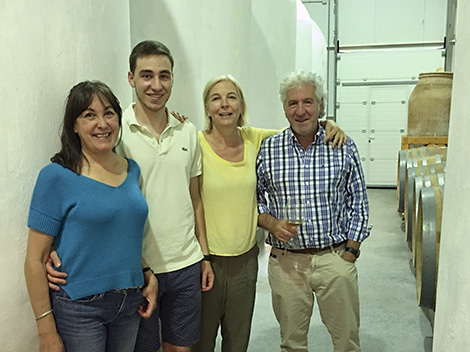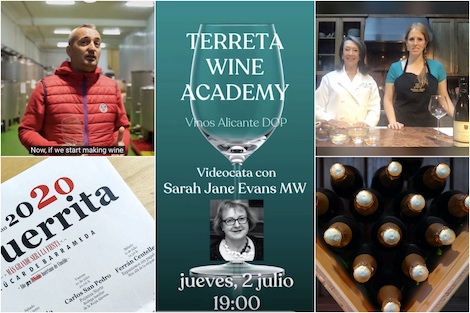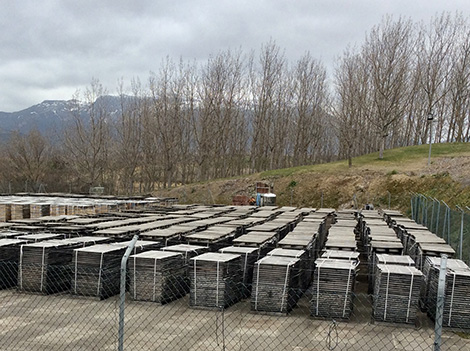The Malvar trilogy and other intriguing wines by Más Que Vinos

“Carlos Falcó set new quality standards in Castilla-La Mancha working with international varieties. We prefer local grapes because they are better adapted to the area,” says Gonzalo Rodríguez.
A consultant at Barón de Ley and other producers in Rioja, Rodríguez launched his consulting business with his partner, agricultural engineer Margarita (May) Madrigal and German winemaker Alexandra Schmedes. But his heart is in Dosbarrios, his family’s village in Toledo. Passionate about birds and countryside life, he loves the extensive plains of this area marked by “wide horizons and broad skies”. In fact, Mesa de Ocaña is a region set on a plateau rising 100 metres above the river Tajo on its left bank with an elevation of 770 to 780 metres above sea level.
Rodríguez’s ancestors were focused on oil rather than wine. In 1935, his grandfather Antonio acted as the secretary of the Spanish Olive Growers Association. The family also produced around 100,000 litres of wine with the region’s traditional clay vessels. Made in a winery in the village’s main square, this red wine was drunk at home and was part of their employees’ wages -back then, labourers received between two and three litres of wine as part of their day’s salary.
Advisors that become producers
Gonzalo Rodríguez met his future wife and partner in one of his first important jobs as an oenologist in Valduero, when this producer had bodegas both in Ribera del Duero and Rioja. He had previous experience as assistant winemaker at the cooperatives in Villadelprado (Gredos) and Manjavacas (Cuenca) where he had the chance to work with Antonio González, a pioneer in cold fermentation techniques (and industrial yeasts) in white wines. Rodríguez even spent a couple of years in one of the huge bottling plants that Savin, one of Spain’s major producers of everyday wines, had all over the country.
Some time later, they met Alexandra Schmedes at Remírez de Ganuza. German-born Alexandra had blind-tasted a few wines from this producer thanks to his colleague and Spanish wine expert David Schwarzwalder and she wasted no time in contacting the Rioja producer for the chance to work with them in Rioja.
Hence the trio was formed and soon their consulting firm set off to work with clients like Palacio Quemado in Extremadura or Adegas Galegas in Galicia. At present, May works full-time in Toledo, while Gonzalo spends much of his time at Barón de Ley and Valserrano in Rioja and Alexandra, who oversees exports for Más Que Vinos, consults for other producers in Rioja like Hacienda Grimón, Heras Cordón and Dominio de Berzal.
The Toledo project began naively with a yeast starter made by May and Gonzalo while they busied themselves with the grapes of a friend's vineyard. But then they discovered how interesting Garnacha and Tempranillo (they call it Cencibel to highlight the fact that they use native clones from massal selections) were in the area. Garnacha is actually Alicante Bouschet, usually called Garnacha Tintorera in Spain, but it was less structured and rustic than the standard for this grape. Despite Alicante Bouschet not being local to this area, they understood the value of their little discovery.
The most succesful achievement of Más Que Vinos is arguably the preservation of biotypes sourced from vineyards which have been uprooted. This material has been used to plant several plots in El Horcajo, the vast 700ha family estate where just five hectares under vine remained. The property is located in Huerta de Valdecarábanos, a village bordering Dosbarrios and Cabañas de Yepes where the trio built their new, modern bodega. Their first plantings, on a wide gully crossed by the Madre de Dios stream, date from 1998. Most of the plots such as La Madre, which is located on the flattest area, El Señorito or the one planted with Malvar are bottled separately as single-vineyard wines.
At a slightly lower latitude, the site is prone to frost (hence the need for vertical trellised systems), but there is more moisture and the grapes ripen later as the ridges on both sides shade the vineyards depriving them from two hours of sunshine. Soils are mostly clay-limestone except for the plot planted to Malvar, which has gypsum soils.
The 22 hectares in El Horcajo are organically grown and all wines are fermented with native yeasts except for the two entry-level Ercavio: the white and the rosé. “In order to achieve authenticity and character you have to take into account the microbiology of the area,” says Gonzalo. The rest of the vineyards, mainly planted to Cencibel and Airén, are old and found in nearby villages. It was tough to identify the most suitable ones but it was even tougher to reach agreements with local growers in order to buy or rent them.
Candy-like wines
The white Malvar is one of the trio’s flagship grape varieties -and perhaps Gonzalo’s favourite. He says it was the indigenous variety in Yepes since the 15th and 16th centuries, but it progressively lost favour because its irregular fruit setting resulted in low yields. Rodríguez remembers that some friends of his father used to say that “Malvar produces candy-like wines”, a description that describes it well as it ripens early, it is high in alcohol and has a distinctive golden colour.
Plant material used in the three hectares of El Horcajo was sourced from a tiny vineyard (half a hectare) which was later uprooted. The vineyard is fenced to prevent rabbits from eating the Malvar shoots and grapes, which are also a very tender treat for the birds as it is the first variety to ripen. Gonzalo loves grapes and birds in equal measure. He seemed just as enthusiastic about showing me the long, loose Malvar clusters as he was about the bustards -he didn’t hesitate to swerve to a cereal field where several of them were resting. Our morning included both the exploration of vineyards and incipient clusters of Airén, Cencibel and the rare white variety Mizancho (a grape with the bright acidity that Airén and Malvar lack) with the sighting of kestrels, bustards and little bustards.
These steppe birds who love open fields with wide horizons live at their ease among cereal crops, vineyards and olive groves bordered by esparto grass, thyme and rosemary. Found on continental climates, steppe ecosystems also have high levels of salinity in their soils. It is therefore no surprise that Más Que Vinos says they make steppe wines. “I have chalky and salty wines,” Gonzalo Rodríguez says.
Back to Malvar, it is difficult to understand why it is so often mistaken with Airén, which could be very well described as its opposite. Airén is a late-budding, late-ripening variety with tight bunches and low alcohol. Despite making the most of old vine Airén in the white Ercavio, the most striking whites produced by Más Que Vinos are made from Malvar.
Their flagship wine is La Malvar de Más Que Vinos (€13, 4,000 botellas) and is made following the traditional style: destemmed grapes are fermented with around 10% to 15% of their “madres” (skins) in old clay vessels locally called tinajas. Ageing takes place in tinajas too with part of the wine spending three months in barrels, yet there is no trace of oak in it. Its most distinctive features are the unctuous, enveloping texture and a bitter edge on the finish. If well-balanced, acidity is not missed. The alcohol adds volume to the palate. I tasted the 2019 and 2017 vintages together (the wine was not made in 2018) and was able to see how well Malvar performs with some bottling aging. Floral notes dominate on the nose alongside ripe white fruit and dried herb aromas.
The new Los Conejos Malditos (literally “damned rabbits”, €10, 10,000 bottles) was made in a similar way in its first 2018 vintage, but no sulfites were added this time. Closer to an orange wine in colour, it displays toasted notes and dried fruit aromas. This wilder style results in a fresh, fleshy palate. In this first attempt at making natural wine, they paid great attention to “the smell of the lees because the wine was not going to be filtered” and “resting the wine in the winery for a whole year before release to stabilize it properly”. On the amusing label, rabbits are portrayed as a gang of troublemakers. The fact is that they are all around the vineyards -it is no exaggeration to say that I saw several dozens during my visit.
The Malvar trilogy is completed with El Vino de Antes (€50, the wine of yesteryear), a rancio-style, oxidative white; only a few hundred bottles have been produced. This is the “candy-like wine”, at least in terms of colour and depth albeit not in terms of the flavour because it is bone dry. Made mainly with grapes from the 2011 vintage, it was fermented in clay vessels and aged in a barrel which was not entirely filled, thus it developed a very thin veil of yeasts. Grapes are sourced from the upper part of the Malvar plot, an area with greater alcohol potential so that fortification can be avoided. This complex, comforting white with quince and dried fruit notes is a new addition to the exciting trend of recovering oxidative wines in Spain.
La Plazuela, an evocative Alicante Bouschet and a carbonic maceration wine
Despite their singular approach to Malvar, the wine that brought notoriety to Mas Que Vinos in Spain was La Plazuela. It has always been regarded as the area’s first fine red made with indigenous grapes. A blend of Cencibel and Garnacha Tintorera (Alicante Bouschet), the share of each varies notably from one vintage to another (2004 was mostly Cencibel, 2002 was dominated by Garnacha). According to the Mas Que Vinos team, vintage variations in the area are marked by the spring rainfall. 2017, 2018 and 2019 were extremely dry years, but this cycle fortunately came to an end this year.
The wine bears the name of the old bodega that used to be located in the village square, “La Plazuela”, as the street sign proclaims. It was conveniently accessible from the family home through an overground corridor. The founding date is engraved in one of the beams: 1881. Although wine production ceased in the 1940s, everything has remained virtually unchanged, with the old clay vessels and part of the ancient tools. At the back, where the wine press once stood, lie now the barrels of La Plazuela. Fermentation takes place in the new winery in Dosbarrios in small stainless steel tanks. Malolactic fermentation and the first stage of ageing is done in concrete cones (confusingly called tinajas too) which were recovered from old bodegas in the area. Concrete, in fact, plays an important role in all the premium reds produced by Más Que Vinos.
Despite its thick stone walls, bodega La Plazuela lies at ground level so temperature can reach 25º C during the summer. “We have to cope with some evaporation losses, but I think that this is also part of the wine’s character,” Gonzalo points out.
Another common feature of this region’s wines is that they all benefit from some cellaring time before their release. “This is the upper plateau in Castilla-La Mancha and it shares some traits with Ribera del Duero”, Rodríguez notes. The current vintage of Ercavio Roble, the most widely available wine in the portfolio with 150,000 bottles, is 2016.
In the case of La Plazuela (around €36 in Spain, 6,000 bottles) it is 2015. The wine regularly combines Alicante Bouschet’s minty, exuberant notes with Cencibel’s deep, consistent ripe fruit. Although high in alcohol, the wine shows good balance, plenty of character and firm structure to develop with time. The 2011 I tried was in great shape.
The most intriguing wine in the portfolio is probably La Garnacha de La Madre (€18, 6,000 bottles). The nose is really striking and exotic (cherry liqueur, sweet spices, black olives, firewood), very different to other Alicante Bouschet wines, and more elegant than one would expect. It was interesting to taste it side by side with Viña El Señorito de Ercavio (€18, 8,000 bottles), a minty Cencibel with lush aromatics (both plots are very close to each other), but with more structure and presence on the palate. Both were 2015s fermented and aged in concrete cones. Could this material excel at enhancing terroir?
The two grapes, Cencibel and Alicante Bouschet, are blended together in a fun young red that benefits from the extensive experience of the trio with carbonic maceration in Rioja Alavesa. This is all about fruit, with some spicy and pencil lead notes. Named 31 de Noviembre as a nod to the release date of Beujolais Nouveau, this is the Spanish version of vins de soif. It also adds further proof of the versatility of grape varieties grown in Castilla-La Mancha.

Amaya Cervera
A wine journalist with almost 30 years' experience, she is the founder of the award-winning Spanish Wine Lover website. In 2023, she won the National Gastronomy Award for Gastronomic Communication
NEWSLETTER
Join our community of Spanish wine lovers






